Despite following a well-defined keyword research process, I often see SEOs, content writers, and marketers take an ineffective approach to keyword research.
But it’s not what they do that’s the problem. It’s what they fail to include in this process that matters – understanding their users’ intent.
Unless your page matches the search intent, you’re not going to earn visibility in traditional search results or AI-generated answers. That's why understanding the reasons why someone conducts a search is crucial for driving a high return on investment in any SEO campaign.
To start, I'll go over the basics of understanding user search intent. Then, I'll dive into a critical, but often overlooked, aspect of the user intent behind the search – how to uncover and understand it at scale.
Key Takeaways
User intent helps define what content to publish to:
- Accompany customers along their buyer’s journey
- Offer relevant content and information that can bring them closer to the brand
- Increase rankings and SERP conversion rate
Table of Contents:
- What is User Intent?
- What Are the Different Types of User Intent?
- What Influences User Intent?
- Why is User Intent Important?
- The Problem With Finding User Intent at Scale
- How to Track User Intent at Scale
- Using Intent Data to Create Your SEO Roadmap
- How to Prioritize Content Production Based on User Intent
Already ready to work intent into your content marketing workflow? Jump down the page!
What is User Intent?
The term user intent (often referred to as searcher intent or keyword intent) refers to the reason behind the search query entered into in Google or AI search. It’s the ultimate goal the the user is trying to achieve.
Their intention could be to find an answer to whatever question they have or advice on how to achieve the desired goal. Maybe the searcher wants to find a place to buy a product they want. Or, maybe they’re just looking for a specific website and forgot its URL.
In each of the above examples, they exhibit an intent.
Search engines continuously reinterpret user intent and adjust results in real time based on behavior, context, and evolving query patterns.
Today, AI-driven systems like Google AI Mode, Perplexity, and ChatGPT, interpret queries using large language models. These LLMs understand context, intent, and topical relationships far more accurately than traditional keyword matching.
What Are the Different Types of User Intent?
There are essentially four different types of search intent. Each search term will fall into one or multiple categories.
1. Informational Intent
Informational intent, or intent to know, helps us obtain specific information, research a particular topic, or learn something new.
Sometimes informational intent is also intent to do, like when asking Google for advice on completing a task or suggestions on gifts for a special occasion.
To identify intent, look at the format of the results — whether that’s SERP features in traditional search or the type of answer generated by AI search platforms. Note: this method is not capable of uncovering intent at scale.
An informational search often presents an Answer Box that immediately answers the user's query. Take the following Google search, for example:

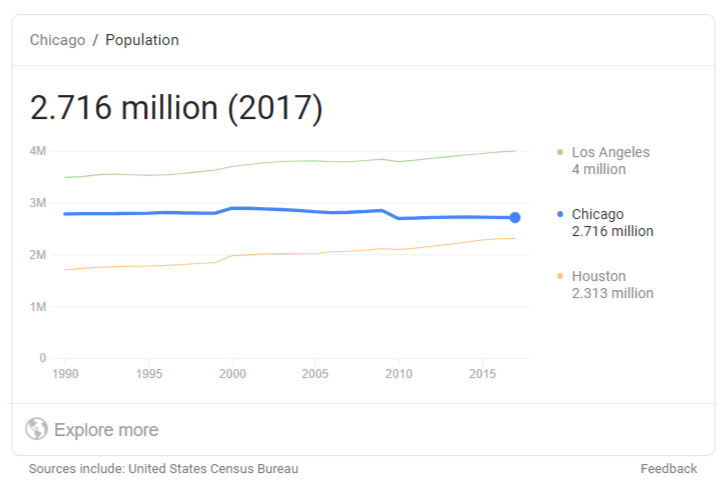
2. Navigational Intent
Navigational intent, or intent to go, defines a desire to go somewhere and interact with the physical world, or to a specific online location.
In the example below, the search query, "Apple," is matched with a navigational intent since the SERP immediately reveals the company's homepage or an AI summary linking to the official site– showing the need to find an online location.

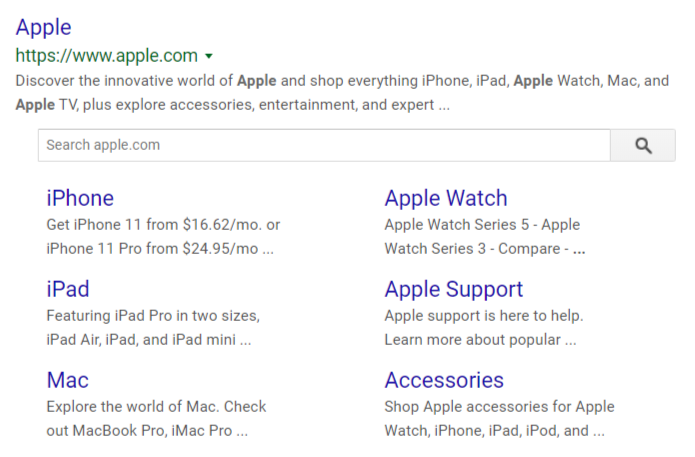
3. Local Intent
Local intent is a navigational query that aims to discover a particular business in the user's vicinity, a physical destination in the real world.
Local intent is shown when a map and/or local pack presents itself, as seen in with the Google search below.

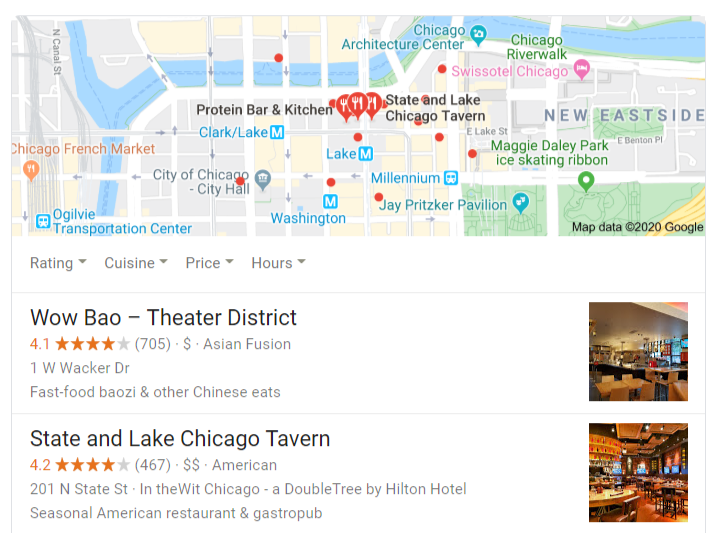
4. Transactional Intent
Transactional intent, or intent to buy, is when the searcher looks for a place to conduct a transaction – purchase a product, hire a service, or exchange funds – hence the term, transactional.
Transactional intent keywords tend to show product listing ads (PLAs), as seen below. Product pages match this intent and are prioritized in the SERP when a query has the intent to purchase.

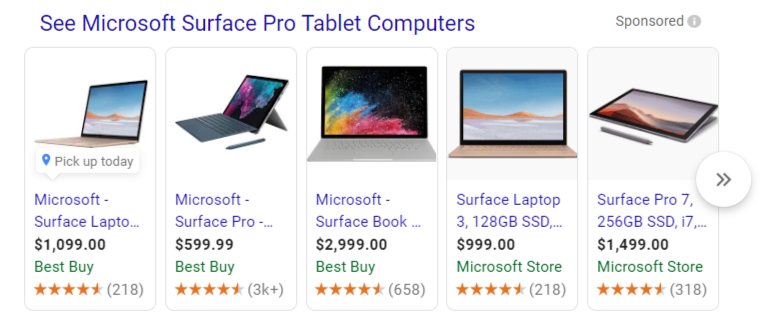
Often, Google refers to the act of searching based on those intents as micro-moments.
What Influences User Intent?
Keyword intent can fluctuate depending on a variety of factors.
Seasonality is one. For example, customers may type in a keyword with the intent of finding information throughout most of the year. But then around the holidays, they may have an intent to buy when searching for that same keyword.
A shift in the type of information users seek about a topic is another example. Consider the keyword ‘iPhone 14.’ At launch, the dominant intent was transactional (buying the new model). But a few years later, the intent shifts toward troubleshooting, repairs, and software updates.
Why is User Intent So Important?
User intent is the foundation of relevance. Search engines want to give people exactly what they expect to find — and if your page doesn’t match that expectation, it won’t perform.
Understanding intent is also crucial for delivering the best search experience possible and effectively guiding the user through their buyer’s journey.
If a result doesn’t match their intent, users move on — whether that’s returning to the SERP or regenerating an AI answer.
For example, let’s assume you’ve created a transactional page for a keyword with informational intent. It simply won’t rank at the top of the SERPs and the content definitely won't provide value for the user.
As my colleague shared with Terakeet:
When someone queries a search engine they not only have a specific intent, they have it at the moment they are searching. So they are in the best possible mindset to be receptive to messages that match well with their intent.”
In addition, modern search engines quickly recognize when a page doesn’t satisfy the user’s intent and adjust visibility accordingly.
If a query has informational intent, they seek advice or answers. They do not want to learn more about a product, let alone buy it (at least, not yet). Your landing page must have content that matches the intent behind the query. In this instance, a blog post or guide would be relevant.
And that’s the incredible power of the user intent. It helps provide one of the most critical factors in today’s SEO – relevance.
Common Methods for Determining User Intent
Many other articles written about user intent recommend a rudimentary way to identify the searcher’s intent.
The typical advice is to search for a keyword and observe what traditional search engines and AI search platforms return. In particular, which Search Features show up – as demonstrated above.
Another manual method is to analyze search modifiers – words in the search query that describe the person’s intent. For example, if a query includes phrases like “how to,” “how do I,” or “what,” for example, then its intent is, most likely, informational.
However, the above methods don't always work – and worse still, they're impossible to scale.
Challenges of Tracking User Intent at Scale
Enterprise companies track thousands (if not tens of thousands) of keywords. As such, these manual methods simply aren't able to provide a proper understanding of user intent across all of your content and pages to connect to your topics and keywords.
But that's not the only problem with them. Both methods above, fail to consider several factors:
- Who is ranking for a particular keyword?
- What information do those pages include?
- What is the language of the search query?
These methods rely solely on what appears in the SERP or the snapshot produced by an AI search engine model, without considering how intent varies across content formats and platforms. As a result, you fail to get a deeper understanding of the information Google promotes within SERPs for the keyword.
How to Track User Intent at Scale
At seoClarity, we overcome all of those challenges, bringing you the first, AI-powered way to identify user intent at scale – because truly, you need a search engine optimization platform if you're looking to scale your efforts.
We've unleashed the power of our user intent capabilities which significantly reduce the time required to research new keywords and create content ideas. They also allow marketing teams to understand an entire topic and create credible content that meets their users' needs at every stage of the buying process.
Additionally, marketers and SEOs can track and measure specific results as well as the impact of intent-driven optimized content.
With the largest, freshest keyword data set, you have access to more than 30+ billion keywords across 170+ countries for your keyword research.
Using AI algorithms, each keyword and topic is accurately categorized into its appropriate user intent designation at scale.
No more scouring the SERP one query at a time for clues.
Using Intent Data to Create Your SEO Roadmap
Let’s create a quick action plan with a quick example scenario.
Consider the query “new puppy” - which saw an increase in demand throughout 2020
 Besides the increase in demand, we also see the number of related keywords (more than half a million!), total search volume of those keywords, and the user intent.
Besides the increase in demand, we also see the number of related keywords (more than half a million!), total search volume of those keywords, and the user intent.

Now I admit, 500,000+ keywords is a lot for anyone to sort through, but this is where things get interesting …
#1. View Current Rankings to See the Existing Market Share
Enter any domain — yours or a competitor’s — to see current rankings next to the related keywords.

Filters can be applied to show you opportunities where you’re not currently ranking well, or at all.
In this case, I filtered between rank positions 11-30. These are great topics to target!
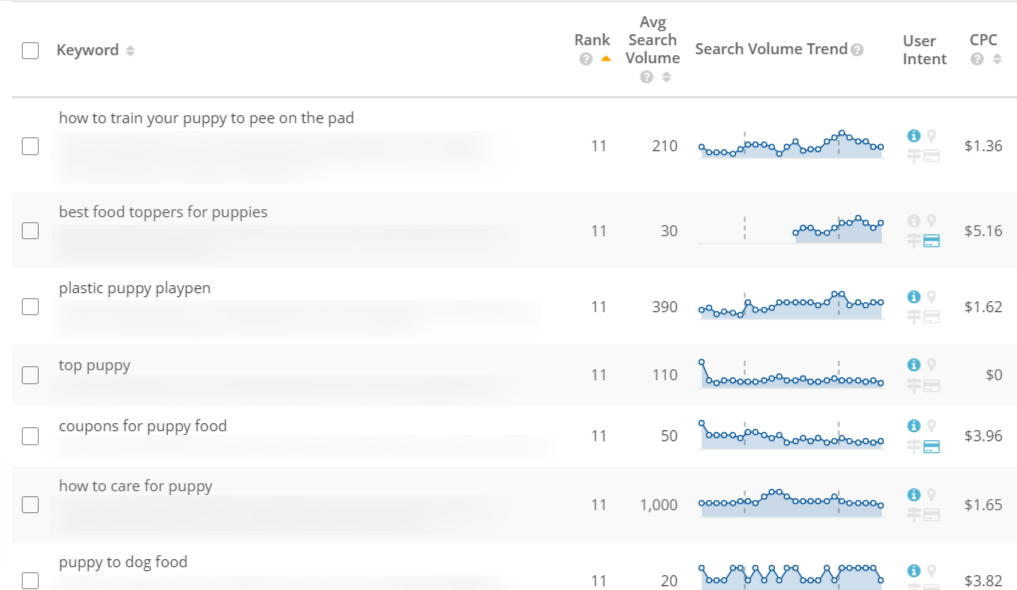
Note: I’ve blurred out the specific URL that ranks for the keyword, which is normally shown directly below the keyword.
You’ll also notice the right-side column shows the user intent of each keyword. Some are informational, some are local or navigational, and some are a combination of the three.
#2. Filter Keywords by User Intent
Knowing the user intent behind the keywords allows SEOs to map them to the right format of content. For instance, if the term had solely transactional intent, or information and transactional intent, that content may fit best on a category page.
For this example, let’s assume we want to locate keywords with an informational intent. We want to create a few blog posts that answer common questions about adopting or training a new puppy.
A simple filter eliminates all non-informational intent keywords and leaves us with what we’re looking for.
.png?width=290&name=Topic-Explorer%20(7).png)
#3. Draw Insights from Intent Topic Patterns
Let’s recap what we’ve done so far: We research the seed word “new puppy,” pulled in the current rankings of a specific domain, and filtered by rank position and intent.
Now, we’re interested in spotting patterns of topics that we can cover in a blog post.
Instead of navigating the list of keywords, we can see pre-arranged keyword patterns.
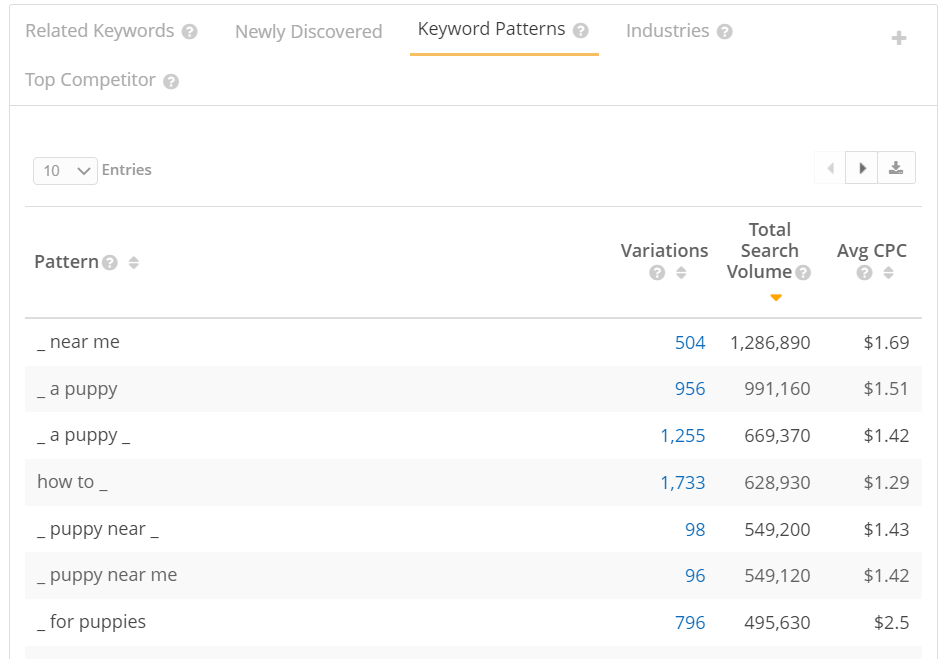
These patterns reveal how users search for keywords with an informational intent. I’m sure you can come up with quite a few ideas to cover just looking at this list!
Note: A high search volume doesn't make a keyword the better choice. It's better to consider intent when choosing topics to cover.
But to see the exact list of keywords, all we’d have to do is click the blue variations number.
You can also filter by SERP features to further narrow down the list. Since we’re targeting informational intent keywords, maybe it’s our end goal to win the Answer Box, or land in the video carousel.
Before formatting content to win SERP features or increase your chances of being recommended by AI search engines, you’d want to see if they appear on the SERP for your target query in the first place!
#4. Build Recommendations
Once we’ve narrowed in on user intent and spotted viable opportunities, we can summarize the insights to develop an actionable strategy.
Note that during this entire process, we weren’t required to add or track these keywords. This was done completely with our keyword research data set.
But, once you identify the keywords that have the best opportunity for your company, you can add them to your keyword portfolio.
Recommended Reading: Create the Best Keyword Portfolio With This Acronym
How to Prioritize Content Production Based on User Intent
The most effective way to win search visibility is by building authority in your topic cluster. This means creating site content that covers aspects of the topic and all user intents.
Recommended Reading: Build Content that Drives Authority with Topic Explorer, Our Topic Cluster Tool
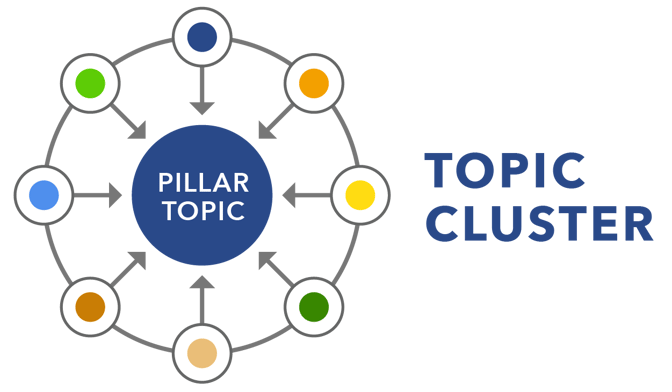
The first step to achieving search visibility, however, is by identifying how much topic coverage you have already. Conduct a thorough content audit to find out. You’ll realize what's missing from your content strategy quickly.
From then on, I recommend focusing on the transactional intent first. By doing so, you’ll provide immediate ROI from your efforts. And with that, you’ll find it easier to target the top-of-the-funnel customers with the informational intent.
Recommended Reading: Finally Reach Your Target Customers With Content Mapping
Our company just completed the process to identify all of their content by intent. It's insane how we are able to segment Top/Middle/Bottom funnel and understand performance and progress for each segment. The entire team is amazed at the dashboards and how easy this process is moving forward within seoClarity."
— Mariam Jameel, SEO Consultant
Conclusion
When researching keywords, you must also consider and identify the user intent behind those search queries, and then match it to content types and topics you want to target.
For enterprise brands especially, you must look for ways to scale your efforts. If you don't, you'll never understand user intent in a way that allows you to create content that significantly boosts search visibility and ROI.
This piece was originally published on March 28, 2019 and has been updated to reflect industry changes and updates to our SEO platform.




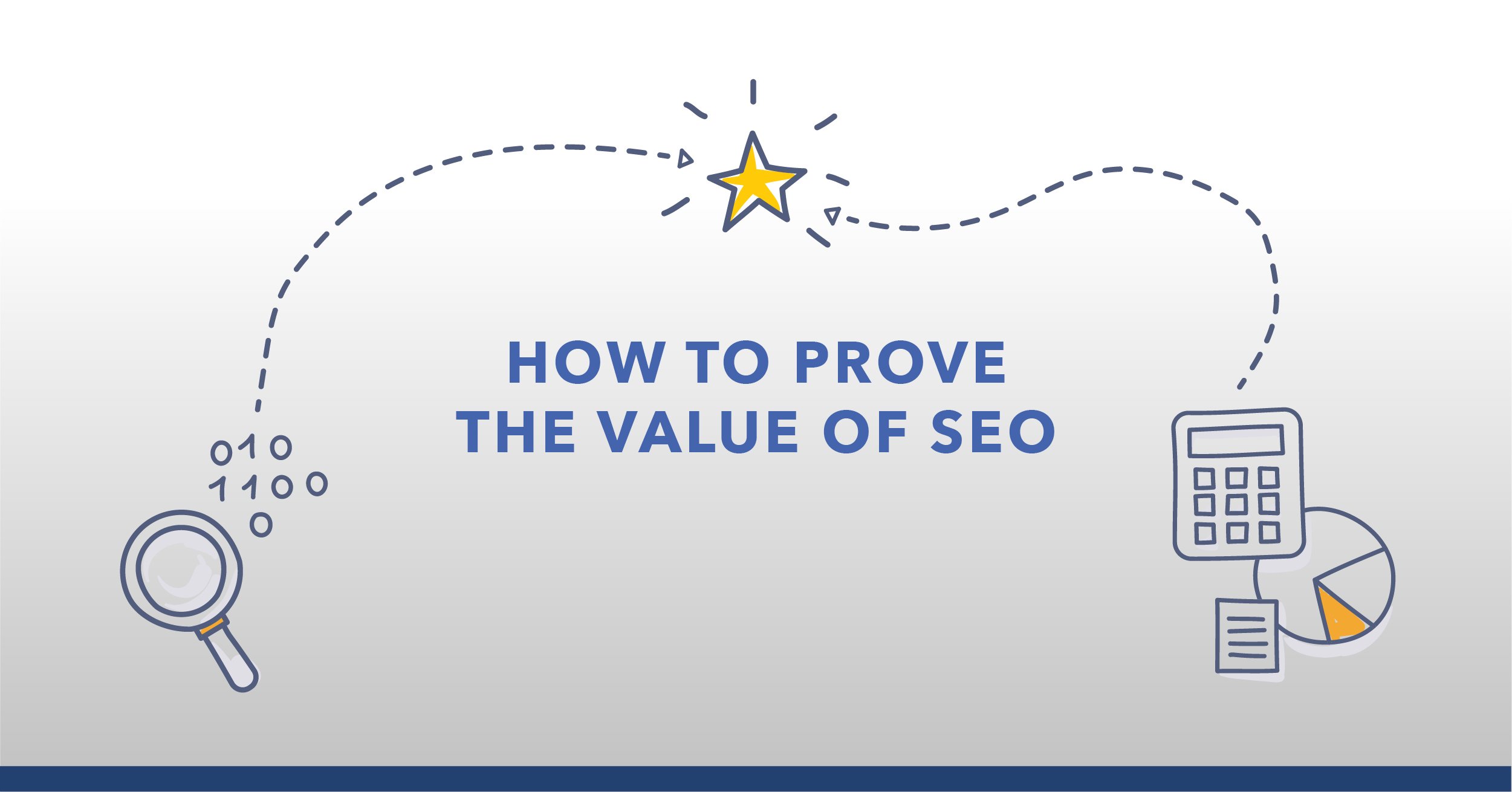
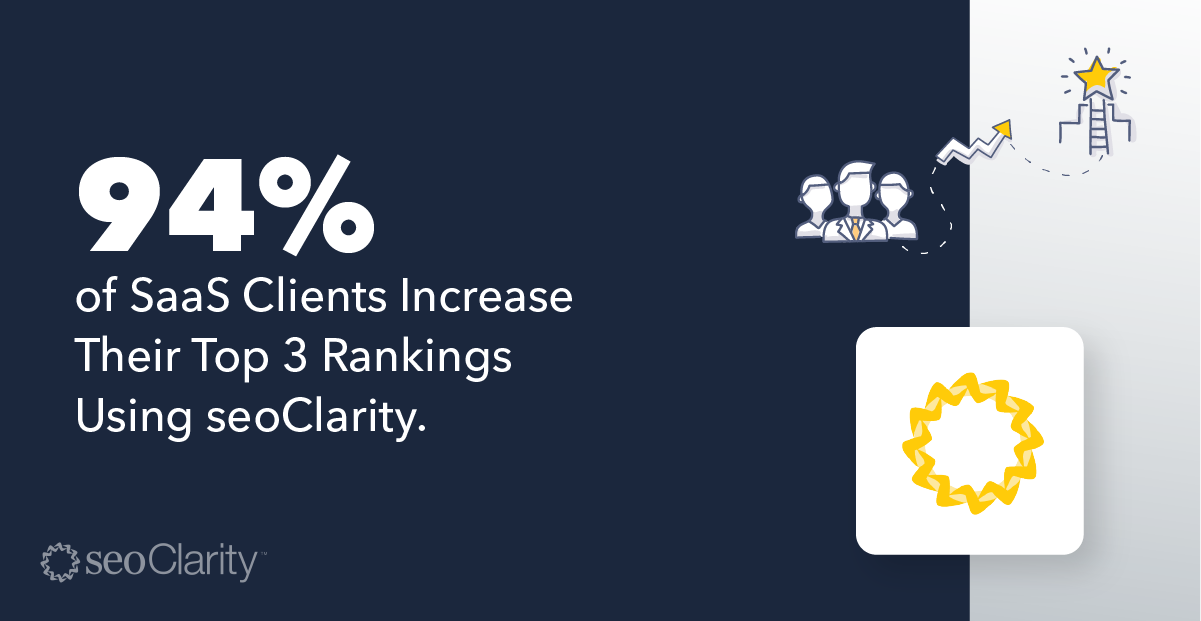

Comments
Currently, there are no comments. Be the first to post one!